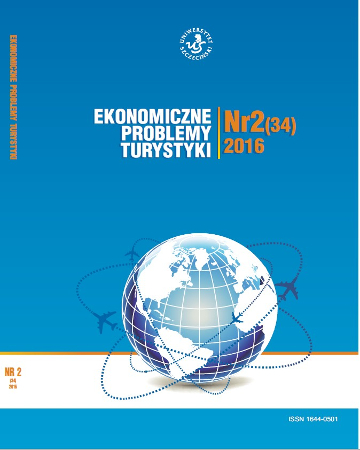
ISSN: 1644-0501
eISSN: 2353-3188
OAI
DOI: 10.18276/ept.2016.2.34-18



Issue archive /
nr 2 (34) 2016
Istota animacji urlopowej i jej rola w kształtowaniu jakości obsługi ruchu turystycznego
(Leisure Time Animation and its Role in Shaping the Quality of Tourist Traffic Service)
| Authors: |
Sylwia
Toczek-Werner
Wyższa Szkoła Handlowa we Wrocławiu |
| Keywords: | tourist traffic quality animation tourist approach |
| Data publikacji całości: | 2016 |
| Page range: | 13 (211-223) |
Abstract
Leisure-time animation plays a significant role in foreign tourist traffic but it's meaning in the development of Polish tourism is not recognised, despite the fact that our country features relevant management of tourist areas and resorts and it has certain traditions in place in the area of organising leisure time for tourists. The research paper talks about a theoretical problem concerning the formation of the quality of tourist traffic service through leisure-time animation, treated as a particular system of activities, and an empirical problem concerning the attitude of tourists towards leisure-time animation and it's relation to the actual participation in the animation programs. In order for this empirical problem to be solved a structural approach to examine these attitudes has been implemented, which consists in the assessment of three of it's aspects: the cognitive, affective and behavioural dimension. The Likert scale has been introduced here as a means of attitude assessment. The results of the research confirm the hypothesis that the current participants of domestic tourist traffic essentially do not participate in leisure-time animation, even if such animation is available and included in the hotel service package, despite having a certain degree of knowledge, positive beliefs and positive feelings about it. The research shows that the participants of the domestic tourist traffic assess the quality of tourist service in Poland as poor and they associate this assessment with the lack of interest of tourism organisers in their expectations in the area of intensification of leisure-time experiences.
Download file
Article file
Bibliography
| 1. | J.B. Bączek, Animator to pijarowiec. Animacja czasu wolnego a budowanie marki hotelu i biura podróży, Rynek Turystyczny, nr 3 (306). |
| 2. | G. Costa, E. Glinia, M. Goudas, A., Panagiotis, Recreational Services in Resort Hotels: Customer satisfaction Aspects, Journal of Sport Tourism, No. 9 (2). |
| 3. | W. Faché, Methodologies for innovation and improvement of services in tourism, Managing Service Quality, t.10/6. |
| 4. | A. Falkowski, T.Tyszka, Psychologia zachowań konsumenckich, Gdańskie Wydawnictwo Psychologiczne, Gdańsk, 2001. |
| 5. | G.R. Foxall, R.E. Goldsmith, Psychologia konsumenta dla menedżera marketingu, 1998. |
| 6. | H. Hahn, K. Finger, Animation im Urlaub, Starnberg, 1975. |
| 7. | M. Kachniewska, Wpływ tendencji występujących po stronie popytu na fenotyp współczesnej turystyki, (w:) Konsument na rynku usług, Szczecin, 2011, Zeszyty Naukowe Uniwersytetu Szczecińskiego, nr 694, Problemy Zarządzania, Finansów i Marketingu nr 22. |
| 8. | B. Kolny, Czas wolny Polaków a usługi turystyczne, Handel Wewnętrzny, nr 5A, Turystyka i rekreacja w rozwoju cywilizacyjnym, 2013. |
| 9. | M. Kopczyńska, Animacja społeczno-kulturalna podstawowe pojęcia i zagadnienia Wydawnictwo Centrum Animacji Kulturalnej, Warszawa, 1993. |
| 10. | Ph. Kotler, Marketing. Analiza, planowanie, wdrażanie i kontrola, Felberg, Warszawa, 1999. |
| 11. | B. Marciszewska, Produkt turystyczny a ekonomia doświadczeń, Wydawnictwo C.H. Beck, Warszawa, 2010. |
| 12. | H. Michels, Animation – Ergebnisse einer Rekonstruktionsanalyse zur freizeitwissenschaftlichen Theoriebildung, Spektrum Freizeit 17, 1995, 2/3. |
| 13. | V.T.C. Middleton, A. Fyall, M. Morgazn, A. Ranchod, Marketing in Travel and Tourism, Butterworth-Heinemann, 2009. |
| 14. | E. Miebach, Animation in einern deutschen Hotel. In: Animation, 1980, 1(2). |
| 15. | D. Mirońska, Zachowania nabywców na rynku - trendy i wpływ na działanie przedsiębiorstw, Zeszyty Naukowe Szkoły Głównej Handlowej w Warszawie, Warszawa, 2010, nr 27. |
| 16. | H. W. Opaschowski, Freizeitökonomie - Marketing. Von Erlebniswelten. Opladen, 1993. |
| 17. | H. W. Opaschowski, Tourismus (Freizeit- und Tourismusstudien), Leske+Budrik, Obladen, 2002. |
| 18. | M. Paczyńska-Jędrycka, P. Eider, Innowacyjność w animacji czasu wolnego szansą rozwoju wybranych destynacji turystycznych, Handel Wewnętrzny, 2014, 6(353). |
| 19. | B.J. Pine, J.H. Gilmore, The experience economy, Harvard Business School Press, Boston, Massachusetts, 1999. |
| 20. | G.F. Ross, Destination evaluation and vacation preferecnce. Annals of Turism Research. Department of psychology. Queensland, 1993. |
| 21. | Słownik języka polskiego PWN 2013, http:// sip.pwn.pl/lista.php?.co=animowany,fxc [dostęp:17.11.2013] |
| 22. | G. Światowy, Zachowania konsumentów, Polskie Wydawnictwo Ekonomiczne, 2006. |
| 23. | S. Toczek-Werner, Nowe zasady i kierunki działań animacyjnych w rekreacji i turystyce, w: Czas wolny, rekreacja, turystyka, hotelarstwo, żywienie. Wyniki badań naukowych, red. W. Siwiński, R.D. Tauber, E. Mucha-Szajek, Wydawnictwo Wyższej Szkoły Hotelarstwa i Gastronomii, Poznań, 2003. |
| 24. | S. Toczek-Werner, Z problemów intensyfikacji wypoczynku urlopowego w warunkach polskich, w: Turystyka i rekreacja jako czynnik integracji europejskiej, red. S. Bosiacki, Wydawnictwo Akademii Wychowania Fizycznego, Poznań, 1995. |
| 25. | E. Zorba, H. Mallaogullari, F. Akcakoyun, F. Konukman, A. Teki, The Examination of Sports, Recreation and Animation Activities of Selected Lodging Types on Services Sales in Turkey, Journal of Sport Tourism, No. 8 (1). |